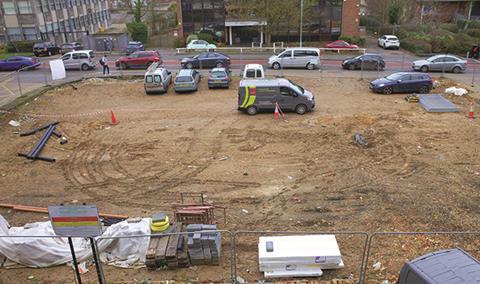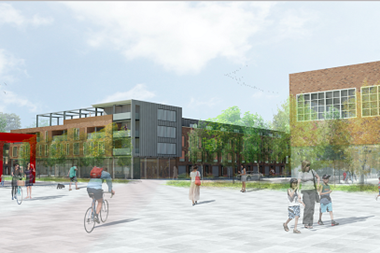It’s a potential boon for developers - but one that has attracted very little attention. By the end of the year, every planning authority in England will have to publish a brownfield land register (BLR) recording previously developed sites that are considered suitable for redevelopment.

The idea is that some sites will then be granted ‘permission in principle’ (PiP), meaning that developers would no longer have to go through the full planning process.
The government’s thinking is that the policy should speed up the development of much-needed new homes in particular, without the need to encroach on the green belt. However, as with most things related to the planning system, it is more complicated and cumbersome than might be immediately apparent.
On the positive side, at the end of July the government published a ‘national data standard’ for BLRs, which clarified the information required and should ensure each authority produces and publishes its register consistently. However, Hannah Spence, senior planner at Boyer, says that there is still room for confusion.
“While this publication provides clarity to ensure BLRs are produced in a consistent manner, it seems its overall success and meaningfulness to achieving the aim of greater certainty, speeding up the planning process or offering a realistic alternative to securing planning permission will rely heavily on the approach adopted by individual planning authorities,” she says.
Two stages
Another issue is the two-stage process. Each council is required to draw up a BLR, but there is no obligation on them to then draw up a second list of which sites will receive PiP. And even for sites that do receive PiPs, developers will still have to apply for a so-called ‘technical details consent’.
“While the production and maintenance of a BLR is mandatory, the decision to move any site to part two of the register, and so granting automatic PiP, is not,” says Spence. “Furthermore, any PiP granted will still be subject to a subsequent technical details consent - the level of detail for which remains vague.”
In theory, councils shouldn’t be averse to designating sites for PiP because it is unlikely to prove politically contentious in the way that reviewing green-belt land can be.
“In a perfect world I’m sure that every authority would be happy to undertake this analysis,” says James Waterhouse, planning director at Iceni Projects. “It’s brownfield land so it shouldn’t be controversial.”
Any PiP granted will still be subject to a subsequent technical details consent - Hannah Spence, Boyer
However, allocating sites for PiP may not be in council planning departments’ best interests - even if an authority is generally pro-development. The problem is that if planning permission is granted automatically, departments will miss out on collecting huge chunks of planning fees from developers.
“The only issue for authorities in terms of the actual granting of PiP is if that was a substitute for outline planning permission, there would be a big reduction in terms of fees,” says Waterhouse.
“If it works really well, developers will go through PiP and not pay any fees. The authority would have to make up the shortfall. Invariably if you’re coming through with a big site right now, it would cost you an awful lot of money.”
Brownfield land registers: a primer
Following the publication of the national data standard for brownfield registers, the planning team at Hogan Lovells drew up a 10-point primer to help the industry get to grips with the new system, summarised as follows:
- Brownfield registers will be in two parts. Part one will set out all brownfield sites suitable for residential development and part two will list the sites granted permission in principle (PiP).
- Before listing a site in part two of the register, the local planning authority (LPA) must carry out the necessary publicity, notification and consultation requirements.
- The part-two entry will specify the range of dwelling numbers considered to be acceptable and may also include non-residential development (such as ground-floor retail or office use) that is compatible with the residential use. PiP will be granted for the development described in the part-two entry without any application from the developer.
- No planning conditions are attached to the PiP. This is left to the technical details consent stage, along with any lawful planning obligations. Any community infrastructure levy payable will become due after the technical details consent stage, at the date that the chargeable development is commenced in the usual way.
- The PiP will usually remain in force for five years, but the LPA may amend this period in certain circumstances. Applications for technical details consent must be submitted and determined within the five years (or any amended period).
- The statutory time limit for determining a technical details consent is 10 weeks for major development and five weeks for minor development. If the application is subject to an environmental impact assessment, a 16-week limit applies.
- Technical details consent applications cannot be made for different phases of the PiP site. The guidance states that the application must include “all matters necessary to enable full planning permission to be granted for the whole site”.
- There is no right of appeal against an LPA’s decision not to enter a site in part two, triggering the grant of PiP. Instead, an applicant would have to use the traditional planning application route. There is a right to appeal to the secretary of state against the refusal or non-determination of an application for technical details consent and a right to appeal against any condition imposed.
- LPAs must monitor their registers and review them at least once a year. New sites can be entered in part two at any time, as long as the correct procedures have been followed.
- If a site is removed from part two, the PiP (or an associated technical details consent) remains valid unless the consents expire or are revoked.
Furthermore, lack of resources available to many councils following seven years of funding cuts may prove to be a critical issue.
Waterhouse notes that drawing up part one of the register should not be too problematic. Authorities already collate and prepare strategic housing and land availability assessments, so the information required is readily available.
Lack of resources
However, Waterhouse points out that the work associated with allocating sites for part two of the register - and therefore granting PiP - will require additional resources.
“I think it all depends on whether councils get around to doing it,” he says. “I know they have until the end of the year to get it in place, but there are plenty of authorities that are unlikely to have it in place by then.
“At the moment, all authorities have to do annual monitoring reports and some of them don’t get around to doing them for a couple of years after they’ve collated the figures. It’s really not helpful, but some of them just have massive resource pressures.”

Spence adds: “While this mechanism may be a step in the right direction to boost housing, its success to achieving meaningful housing delivery will be heavily reliant on already under-resourced and cash-strapped planning departments.”
So while there is potential for PiP to speed up the planning system and deliver more new homes on brownfield land, it is hardly the silver bullet many developers have been demanding from government.































No comments yet